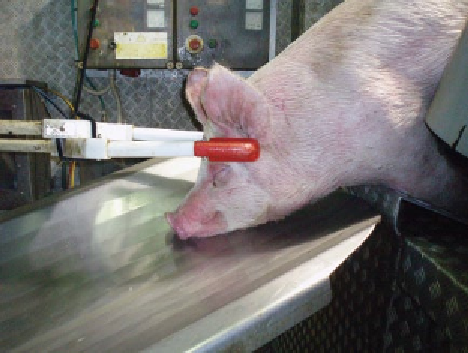Agriculture Reference
In-Depth Information
hinged metal plates which hang down inside the second
conveyer and contact the animal's head as it passes
through. The stunning voltage is of the order 600-1000 V.
Ninety percent of the pigs are killed; the remaining 10%
are only stunned. Difficulties may be encountered with
this system in maintaining a consistently correct posi-
tioning of the electrodes across the brain of the pig. It is
particularly important that a backup stunner is always
present to deal with any animal which suffers poor posi-
tioning of the electrodes, resulting in only partial stun-
ning. Automated electrical stunning systems using chest
belt conveyers have an improved accuracy due to the use
of photo sensors to aid accurate placement of the elec-
trodes and accurate positioning of the animal's head.
Figure 7.6
Electrical stunning tongs in use (Reproduced with
permission from John Hood).
Head-to-brisket stunning of cattle
The high-voltage
head-to-brisket
system was first devel-
oped in New Zealand for religious slaughter of cattle.
Electrodes are applied to the animal in a purpose-built
stunning pen following capture in a neck yoke. On cap-
ture, a chin lift operates from which a nose contact plate
is applied. A current to a maximum of 3.5 A (at 550 V,
50 Hz) is applied between the nose and neck yoke for
3 seconds to stun the animal, with an additional current
applied between the neck and brisket via a pneumatically
positioned electrode between the animal's forelegs, to
produce cardiac arrest.
Studies carried out by Wotton
et al.
(2000) demon-
strated that an effective stun could be achieved in cattle
utilising the head electrodes only with currents as low as
0.46 A when applied for 3 seconds or 1.15 A for 1 second.
In the cardiac arrest cycle, the maximum current sur-
vived by an animal was 1.51A from which it can be
deduced that if the current is sufficient to cause cardiac
arrest there must always be sufficient to cause an effec-
tive stun. Evidence suggests that successful induction of
unconsciousness and cardiac fibrillation is associated
with gasping and/or rhythmic breathing movements in
the majority of animals and rotation of the eyeball in
some, and resumption of corneal and palpebral reflexes
in a few. However, these responses are subsequently lost
and brain death occurs without the resumption of con-
sciousness. It has been suggested that these brainstem
reflexes observed particularly after short duration car-
diac arrest stuns do not indicate recovery and can there-
fore be ignored under these specific circumstances as
long as ventricular fibrillation has been achieved.
Low-voltage electrical stunning
Low-voltage electrical stunning, defined as using less than
150 V is no longer recommended by many authorities,
including the Humane Slaughter Association. It consists of
a control panel, on which voltage can be adjusted, meters
capable of measuring the current and voltage as it is applied,
and a pair of tongs with terminal electrodes for application
to the sides of the animal's head. In order to create a better
contact, the electrodes are immersed in a saline solution
before use or possess in-built water jets. Many tongs sys-
tems are now capable of delivering in excess of 250 V safely.
For
head-only
electrical stunning systems, a minimum
electric current of 400 mA for pigs, and 250 mA for sheep
and lambs, has been recommended to produce an effec-
tive stun when the tongs are placed in the ideal position.
However, most experts set their recommendations con-
siderably higher at 1.0 A for sheep, 0.6 A for lambs, 1.3 A
for pigs and 1.5 A for cattle, having made the assumption
that tong placement on the head would frequently be far
from ideal.
High-voltage electrical stunning
Investigations into electrical stunning have shown that
high-voltage systems using 300 V or above are more
effective than low-voltage systems provided they are
used with automatic restrainers and with due regard to
operator safety. The application time must be at least 3
seconds. Fractures (vertebrae and scapula) may occur in
pigs stunned on the floor.
High-voltage electrical systems for pigs are available
in a fully automatic form which incorporates two
V-shaped restrainer-conveyors. These are placed in
series and move at different speeds so that the animals
are separated sufficiently to present their heads for stun-
ning to a set of specially shaped electrodes suspended on
Head to back/leg stunning of pigs and sheep
High-voltage electrical stunning in addition to being
used for head-only application, may incorporate special
electrodes through which current is applied simultane-
ously to the head and back/leg. In this system, the brain

